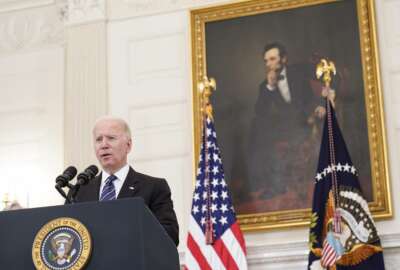Biden’s DEIA strategy seeks to better understand federal employees’ challenges
The administration will elevate the role of chief diversity officers to help lead agency DEIA implementation teams and conduct quarterly updates to track progress...
The Biden administration, in its effort to make the federal government a model employer for the rest of the country, is looking to better understand the workplace experiences of federal employees.
To meet that goal, the administration on Tuesday released the first governmentwide diversity, equity, inclusion and accessibility strategy in a decade.
The administration, under the strategy, will elevate the role of chief diversity officers within each agency, who in turn will help lead dedicated agency DEIA implementation teams and conduct quarterly updates to track progress in meeting governmentwide goals.
To better understand challenges experienced by federal employees and those looking to join the federal workforce, each agency implementation team will publish its own DEIA strategic plans by March 23.
“Even with decades of progress building a federal workforce that draws from the full diversity of the nation, many underserved communities remain under-represented in the federal workforce, especially in positions of leadership,” the strategy states.
The governmentwide DEIA strategy builds off momentum from an executive order President Joe Biden signed in June to promote these same principles across the federal workforce.
The executive order directed agencies to identify hurdles that prevented recruiting, hiring, retaining and promoting individuals from underserved populations. It also told agencies to flag obstacles these same individuals might face with professional development, pay and compensation, or training and reasonable accommodations.
The strategy is the most recent governmentwide approach to diversity and inclusion since the Obama administration launched its vision for meeting these goals a decade ago.
The strategy calls on agencies to utilize tools developed under the Federal Data Strategy and the Evidence Act, which mandated chief data officers and chief evaluation officers at every agency, to implement a “data-driven approach to DEIA.”
As part of this data work, the administration directs agencies to conduct analysis of workforce demographic data and evidence gathered at all stages of the hiring process — including recruitment, advancement and retention.
The Office of Personnel Management, meanwhile, is helping agencies understand their own DEIA workforce data, a process that some have found challenging.
Some agencies ask their employees or job applicants to self-identity certain demographic details about themselves, but the federal government as a whole doesn’t have a systematic way to collect that data accurately.
The administration, meanwhile, links progress in improving diversity and inclusion inside the federal workforce as having a direct impact on its related priority of promoting equity in public-facing government services.
Acting OMB Director Shalanda Young, in a blog post this summer, said the federal government, as the country’s largest employer and buyer of goods, needs better data to understand its blind spots and to empower the federal workforce “to be change agents for equity.”
Young was in fact nominated to be the first Black woman to lead OMB today, the Biden administration announced.
The strategy directs agencies to include DEIA implementation teams in drafting planning documents such as their annual budget requests, strategic plans and upcoming learning agendas.
“Ensuring DEIA implementation and assessment is the responsibility of the entire workforce, not the job of one person or office,” the strategy states.
To that end, the administration’s strategy directs agencies to loop their chief information officers and chief procurement officers into the work of the DEIA implementation teams.
The strategy also reflects the administration’s vision for its President’s Management Agenda.
The PMA vision features strengthening and empowering the federal workforce as one of three top priorities — along with improving the delivery equity of government customer experiences and empowering government services to “build back better.”
Administration officials said values of equity, dignity, accountability and results will underscore all of the PMA priorities.
The strategy sets goals for the federal government to be a model workplace for LGBTQI+ employees, and workers with disabilities. It also seeks to expand federal hiring opportunities for formerly incarcerated individuals.
OPM, to that end, recently posted a notice in the Federal Register that would allow same-sex spouses of deceased federal employees a chance to apply for survivor benefits.
As for formerly incarcerated individuals seeking federal employees, OPM finalized a rule in 2016 that would, with some limits and exceptions, delay criminal history checks for prospective federal employees until after an agency issued a conditional offer of employment to an applicant. The Obama administration said the “ban the box” rule change would prevent candidates from being eliminated before they have a chance to demonstrate their qualifications.
The House Oversight and Reform Committee in 2019 advanced the Fair Chance Act, which would codify the “ban the box” regulation into law. The bill, however, never received a House or Senate floor vote.
The administration under this strategy will also create a framework to address workplace harassment and sexual harassment in the federal workforce. Agency strategic plans will include comprehensive reviews of agency policies and processes for responding to harassment and supporting federal employees who have experienced domestic violence, sexual assault or stalking.
As part of those reviews, the strategy directs agencies to update their policies and training within 120 days of submitting their DEIA plans.
In order for the federal government to become a model employer for all demographics, the strategy outlines a series of roadmaps for agencies to follow:
- Diversity goals include creating multi-year hiring projects of agency hiring needs and developing a diverse pool of applicants based around those needs.
- Equity goals include running pay equity audits to ensure employees are fairly for their work.
- Inclusion goals include providing reasonable accommodations for employees with disabilities and making accessibility a “core design component” of federal buildings and websites.
As part of its accessibility goals, OMB is working with the General Services Administration, U.S. Access Board, and Chief Information Officer Council to review and update existing accessibility guidelines, and help agencies “build and sustain an accessible technology environment.”
This interagency work would include ensuring that all technology, whether developed in-house or externally, is compliant with Section 508 of the Rehabilitation Act before it’s used by federal employees.
Copyright © 2025 Federal News Network. All rights reserved. This website is not intended for users located within the European Economic Area.
Jory Heckman is a reporter at Federal News Network covering U.S. Postal Service, IRS, big data and technology issues.
Follow @jheckmanWFED






